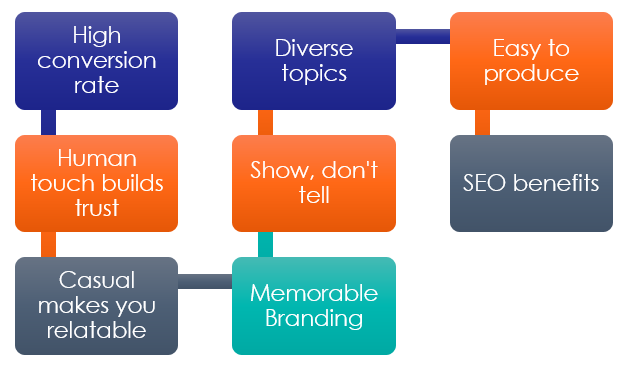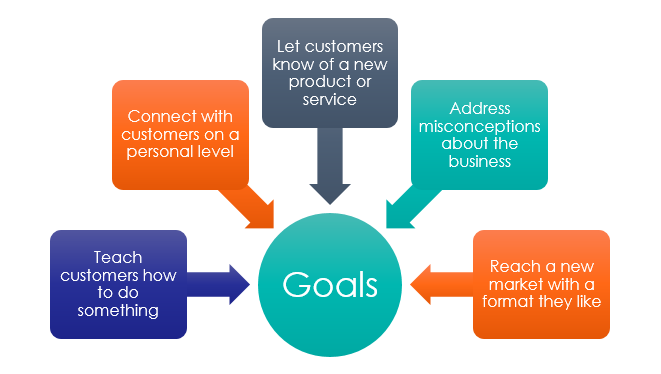Welcome to
On-Camera Video Tricks and TipsConnect with your audience & build trust with quick, simple face-to-face videos
Introduction: How On-Camera, Face-to-Face Video Fits into Your Business
High quality videos are an essential part of content marketing today. What we call “on camera” (or “talking head”) videos are simple videos that show a speaker talking to the camera, without fancy effects, animation, and action. The video shows a person talking to the viewer and presenting useful information or explaining how to do things.
These types of videos are a critical part of your marketing, because they give you the opportunity to connect in a more personal way with your audience. When they hear your voice AND see your face, they know you’re a real person. And that’s what starts to build the trust that forms lasting relationships with followers and customers.
On-camera videos are also far easier to make than you might first imagine. All you have to do is set up your space, hit record, and talk. Get a good take and maybe edit a little, and you have a video that’s ready for YouTube, Facebook, your blog, or anywhere else that you need to form a connection with your audience.
The only problem is that for many people, getting in front of a camera is a terrifying prospect. If you’ve not spent a great deal of time in front of a camera, creating even the simplest video like this may be a huge challenge. You may feel self-conscious, hate the sound of your own voice, or feel that you don’t look “professional.” There are also the technical challenges to overcome.
In this course, you’ll learn how to create a basic studio set up and create on-camera videos with ease. At first, it’ll be a bit awkward, but you’ll learn tips to help you create more professional videos, and quickly overcome the unfamiliarity of speaking in front of a camera. You don’t need to be an actor or have any experience whatsoever. You just need some strategies under your belt and a bit of practice.
What’s important to understand about a brand is that it has nothing to do with the actual product. It exists in the minds of customers only. As mentioned in the definition, a brand is a perceived image.
Brands are often confused with logos and identities. A brand identity consists of the image or design motifs. The logo is just one design that communicates the brand. Both are involved in communicating the brand’s message, but a brand is much bigger and more encompassing than that. It also includes the images or feelings that the design or logo invokes.
In his definition, Godin mentions ‘value.’ The importance of a brand is that it offers a unique perceived value that a customer doesn’t get from your competitors. In other words, the brand is the reason your customers choose you. A good brand tells customer that this is not only the best choice for them, but the only choice that offers the unique solution they’re looking for.
From the point of view of your business, your brand is the promise you make to your customers. It precedes and underlies all of your marketing and, if done well, every contact the customer has with your company.
Emotional Connection. All good brands make an emotional connection with their target audience. People identify themselves through the brands they like. It’s just as much a part of a person’s identity as their political or religious affiliation. If your brand gets inside your customers’ heads and elicits an emotional response, they’ll identify with it and remain loyal. This is what motivates the buyer to buy.
Credibility. A good brand is consistent. It never strays from the customer’s expectation. Like an old friend, it’s always there giving them the same message. In this way, your brand establishes your company’s credibility in the customer’s mind.
Timeless. The best brands are timeless. They endure and stay relevant for years or even decades to come.
Why Your Business Needs On-Camera Videos

Videos generally perform better than any other type of content online and especially on social media. Businesses produce videos because they offer high conversions. Partly, that’s because video is easy for your audience to digest and many people prefer to take in information in video form rather than by reading text.
On-camera videos help your business by giving it a human face, and this engenders trust. Especially for online businesses where there isn’t typically much face-to-face contact with your customers, you need to create this type of human connection. Your on-camera videos show the world who you are, and show that your business is legitimate. You’re not just some ecommerce site on autopilot.
Since on-camera videos can be casual, this informal feeling also helps to lend credibility. Your best on-camera video isn’t a slick studio production. It shows that you’re an ordinary person, just like your audience.
Video is also excellent for branding. It gives you a chance to show the world who you are and it helps you to create an accurate image of your brand in your audience’s minds. Your videos make you memorable.
With on-camera video, you can show and not just tell. If you’re explaining to your audience how to do something, you can demonstrate it for them at the same time. This is better than simple text with illustrations. A plumber can show how to un-stuck a sink; a mechanic can demonstrate a simple trick to get your car running better; an artist can show step-by-step how to create a certain craft; you can show your audience exactly how to get their golf swing right; and so on.
On-camera videos can cover many different areas of your business. You can teach people how to do things, introduce the members of your staff, explain tips to help people overcome their problems, take people “behind the scenes” in your business or industry, promote new products, and more.
Finally, on-camera videos are easy to produce. After you make the first few, you’ll get into a flow where you can crank out a video whenever you have an idea for one. You’ll think of a good topic, do a quick set-up, and less than an hour later you’ll have a video up online. You don’t need to worry about all of the expenses and resources that go into more complex videos. When I first started doing video’s it would take me an hour to do a one minute video because I’d have 50 takes. But now I’m down to knocking it out in about 5 minutes. You can too…
The videos you produce will offer valuable content to the world that will get you exposure, SEO benefits, new eyes on your business, and potentially more sales. You’ll have a whole new type of content to mix in with your text, visual, and other content.
The overall goal for your video can be as broad or as specific as you like; but it’s good to identify a primary purpose for your video creation that will guide your decisions throughout the process.
Examples of common goals for businesses when creating on-camera video include:

- Teach customers how to do something that requires more than just screen sharing. For example, showing how to fold up your portable pop-up photo backdrop requires a video of someone actually folding it.
- Connect with customers on a personal level, which is best done face-to-face. When you can’t actually see someone in person in real time, an on-camera video can give the same sense of connection. It’s also the easiest way to convey your thoughts and feelings, since people can see and hear you. That’s one of the quickest ways to build trust.
- Let customers know of a new product or service. Seeing a real person announce the latest news from your business gives it more weight and importance.
- Address misconceptions about the business. When dispelling objections or addressing anything negative about your business, people need to see your face to know that you’re sincere.
- Reach a new market with a format they like. Some people in your audience just prefer to see who they’re dealing with.
Naturally, these examples don’t cover all the goals you might have for on-camera video. Think about where you need to make a more personal connection with your audience. What do you want to achieve through that connection? That’s your goal for your video.
-
By the time you finish this course, you’ll be able to:
- Identify how you can use on-camera videos for your business and what results you can expect to get.
- Use the equipment you have at your disposal to produce videos, and decide what additional equipment you need.
- Pick topics for videos and outline your script so that you’ll be ready once the camera starts rolling, and you’ll get your point across clearly.
- Star in your own on-camera videos and look natural, speak comfortably, and feel relaxed in front of the camera with just a little practice.
- Save, render, and do simple edits on your video so that it’s ready to post online where your audience will see it.
Activity:
- Identify what’s holding you back from creating on-camera, face-to-face videos.
- List the main benefits you’ll gain in your business from getting in front of a camera and recording short videos.
- Write down the overall goal for one short on-camera video you’ll focus on throughout the course.
A Word
From Tamara
As an entrepreneur myself I completely understand the stress, anxiety and frustration around launching or growing a business. I also know the rewards and life style change the hard work can provide you if you stay focused. I am here to inspire and motivate you to push forward. The fact that you’re investing in your business education let’s me know you’re in this to win. Rest assured I’m here to help you…. These courses are set up to help you understand the basics. To dig deeper into your specific plan of action we will discuss where you are, where you want to be, eliminate any blocks preventing you from getting to the next step and create an action plan.

Our superpower is making you a superhero.

